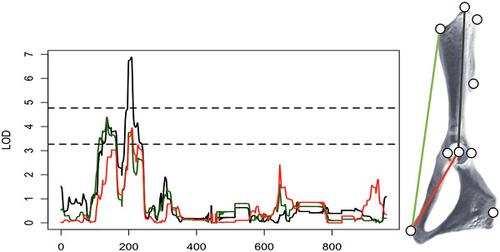当前位置:
X-MOL 学术
›
J. Exp. Zool. B Mol. Dev. Evol.
›
论文详情
Our official English website, www.x-mol.net, welcomes your feedback! (Note: you will need to create a separate account there.)
Variation in mouse pelvic morphology maps to locations enriched in Sox9 Class II and Pitx1 regulatory features.
Journal of Experimental Zoology-B: Molecular and Developmental Evolution ( IF 2.2 ) Pub Date : 2020-02-03 , DOI: 10.1002/jez.b.22926 Charles C Roseman 1 , Terence D Capellini 2 , Evelyn Jagoda 2 , Scott A Williams 3, 4 , Mark Grabowski 5 , Christine O'Connor 6, 7 , John D Polk 8, 9 , James M Cheverud 10
Journal of Experimental Zoology-B: Molecular and Developmental Evolution ( IF 2.2 ) Pub Date : 2020-02-03 , DOI: 10.1002/jez.b.22926 Charles C Roseman 1 , Terence D Capellini 2 , Evelyn Jagoda 2 , Scott A Williams 3, 4 , Mark Grabowski 5 , Christine O'Connor 6, 7 , John D Polk 8, 9 , James M Cheverud 10
Affiliation

|
Variation in pelvic morphology has a complex genetic basis and its patterning and specification is governed by conserved developmental pathways. Whether the mechanisms underlying the differentiation and specification of the pelvis also produce the morphological covariation on which natural selection may act, is still an open question in evolutionary developmental biology. We use high-resolution quantitative trait locus (QTL) mapping in the F34 generation of an advanced intercross experiment (LG,SM-G34 ) to characterize the genetic architecture of the mouse pelvis. We test the prediction that genomic features linked to developmental patterning and differentiation of the hind limb and pelvis and the regulation of chondrogenesis are overrepresented in QTL. We find 31 single QTL trait associations at the genome- or chromosome-wise significance level coalescing to 27 pleiotropic loci. We recover further QTL at a more relaxed significance threshold replicating locations found in a previous experiment in an earlier generation of the same population. QTL were more likely than chance to harbor Pitx1 and Sox9 Class II chromatin immunoprecipitation-seq features active during development of skeletal features. There was weak or no support for the enrichment of seven more categories of developmental features drawn from the literature. Our results suggest that genotypic variation is channeled through a subset of developmental processes involved in the generation of phenotypic variation in the pelvis. This finding indicates that the evolvability of complex traits may be subject to biases not evident from patterns of covariance among morphological features or developmental patterning when either is considered in isolation.
中文翻译:

小鼠骨盆形态的变化映射到丰富了Sox9 II类和Pitx1调控功能的位置。
骨盆形态的变异具有复杂的遗传基础,其模式和规格受保守的发育途径支配。骨盆分化和规范的潜在机制是否也会产生自然选择可能作用的形态协变,仍然是进化发育生物学中的一个未决问题。我们在高级交叉实验(LG,SM-G34)的F34代中使用高分辨率定量性状基因座(QTL)定位来表征小鼠骨盆的遗传结构。我们测试了以下预测:在QTL中,与后肢和骨盆的发育模式和分化以及软骨形成的调节相关的基因组特征被过度代表。我们发现在基因组或染色体显着性水平上的31个单一QTL性状关联与27个多效性基因座合并。我们在更轻松的显着性阈值复制位置恢复了进一步的QTL,该位置在以前的实验中在同一种群的较早一代中发现。QTL更有可能在骨骼特征形成过程中保留活跃的Pitx1和Sox9 II类染色质免疫沉淀序列特征。对从文献中得出的七种以上发展特征的丰富化缺乏支持或缺乏支持。我们的研究结果表明,基因型变异是通过参与骨盆表型变异产生的一部分发育过程来引导的。
更新日期:2020-04-14
中文翻译:

小鼠骨盆形态的变化映射到丰富了Sox9 II类和Pitx1调控功能的位置。
骨盆形态的变异具有复杂的遗传基础,其模式和规格受保守的发育途径支配。骨盆分化和规范的潜在机制是否也会产生自然选择可能作用的形态协变,仍然是进化发育生物学中的一个未决问题。我们在高级交叉实验(LG,SM-G34)的F34代中使用高分辨率定量性状基因座(QTL)定位来表征小鼠骨盆的遗传结构。我们测试了以下预测:在QTL中,与后肢和骨盆的发育模式和分化以及软骨形成的调节相关的基因组特征被过度代表。我们发现在基因组或染色体显着性水平上的31个单一QTL性状关联与27个多效性基因座合并。我们在更轻松的显着性阈值复制位置恢复了进一步的QTL,该位置在以前的实验中在同一种群的较早一代中发现。QTL更有可能在骨骼特征形成过程中保留活跃的Pitx1和Sox9 II类染色质免疫沉淀序列特征。对从文献中得出的七种以上发展特征的丰富化缺乏支持或缺乏支持。我们的研究结果表明,基因型变异是通过参与骨盆表型变异产生的一部分发育过程来引导的。



























 京公网安备 11010802027423号
京公网安备 11010802027423号